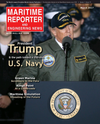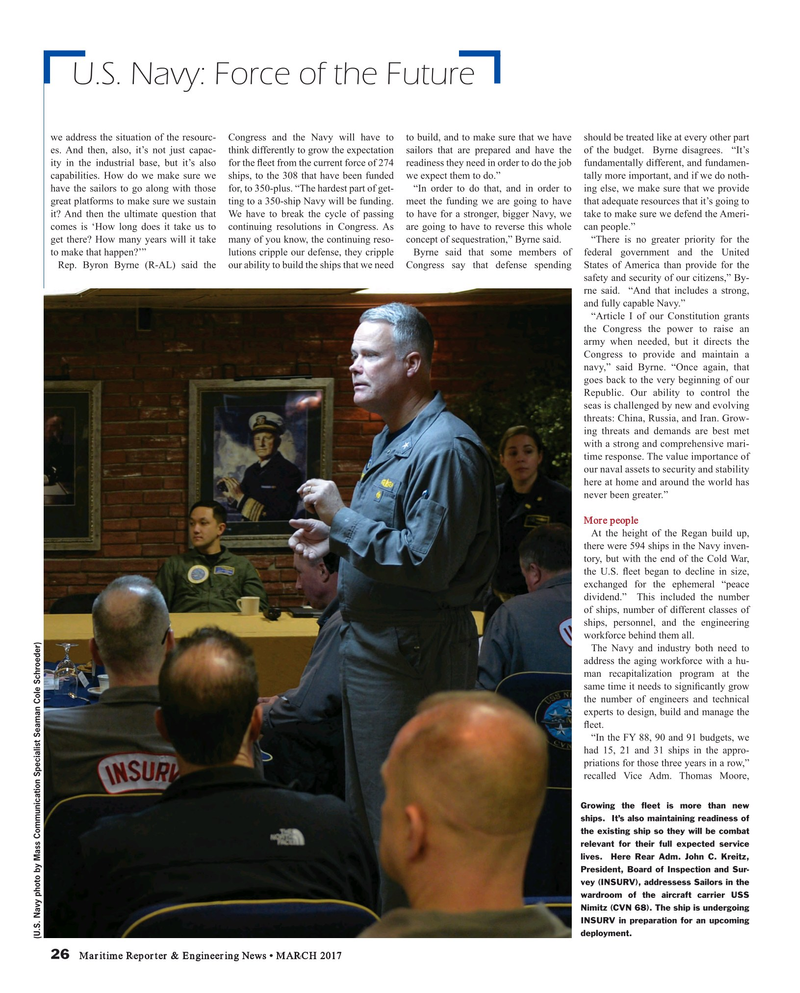
Page 26: of Maritime Reporter Magazine (March 2017)
U.S. Navy Quarterly & Maritime Simulation Technologies
Read this page in Pdf, Flash or Html5 edition of March 2017 Maritime Reporter Magazine
U.S. Navy: Force of the Future we address the situation of the resourc- Congress and the Navy will have to to build, and to make sure that we have should be treated like at every other part es. And then, also, it’s not just capac- think differently to grow the expectation sailors that are prepared and have the of the budget. Byrne disagrees. “It’s ity in the industrial base, but it’s also for the ? eet from the current force of 274 readiness they need in order to do the job fundamentally different, and fundamen- capabilities. How do we make sure we ships, to the 308 that have been funded we expect them to do.” tally more important, and if we do noth- have the sailors to go along with those for, to 350-plus. “The hardest part of get- “In order to do that, and in order to ing else, we make sure that we provide great platforms to make sure we sustain ting to a 350-ship Navy will be funding. meet the funding we are going to have that adequate resources that it’s going to it? And then the ultimate question that We have to break the cycle of passing to have for a stronger, bigger Navy, we take to make sure we defend the Ameri- comes is ‘How long does it take us to continuing resolutions in Congress. As are going to have to reverse this whole can people.” get there? How many years will it take many of you know, the continuing reso- concept of sequestration,” Byrne said. “There is no greater priority for the to make that happen?’” lutions cripple our defense, they cripple Byrne said that some members of federal government and the United
Rep. Byron Byrne (R-AL) said the our ability to build the ships that we need Congress say that defense spending States of America than provide for the safety and security of our citizens,” By- rne said. “And that includes a strong, and fully capable Navy.” “Article I of our Constitution grants the Congress the power to raise an army when needed, but it directs the
Congress to provide and maintain a navy,” said Byrne. “Once again, that goes back to the very beginning of our
Republic. Our ability to control the seas is challenged by new and evolving threats: China, Russia, and Iran. Grow- ing threats and demands are best met with a strong and comprehensive mari- time response. The value importance of our naval assets to security and stability here at home and around the world has never been greater.”
More people
At the height of the Regan build up, there were 594 ships in the Navy inven- tory, but with the end of the Cold War, the U.S. ? eet began to decline in size, exchanged for the ephemeral “peace dividend.” This included the number of ships, number of different classes of ships, personnel, and the engineering workforce behind them all.
The Navy and industry both need to address the aging workforce with a hu- man recapitalization program at the same time it needs to signi? cantly grow the number of engineers and technical experts to design, build and manage the ? eet.
“In the FY 88, 90 and 91 budgets, we had 15, 21 and 31 ships in the appro- priations for those three years in a row,” recalled Vice Adm. Thomas Moore,
Growing the ? eet is more than new ships. It’s also maintaining readiness of the existing ship so they will be combat relevant for their full expected service lives. Here Rear Adm. John C. Kreitz,
President, Board of Inspection and Sur- vey (INSURV), addressess Sailors in the wardroom of the aircraft carrier USS
Nimitz (CVN 68). The ship is undergoing
INSURV in preparation for an upcoming deployment. (U.S. Navy photo by Mass Communication Specialist Seaman Cole Schroeder) 26 Maritime Reporter & Engineering News • MARCH 2017
MR #3 (26-33).indd 26 MR #3 (26-33).indd 26 3/7/2017 4:09:54 PM3/7/2017 4:09:54 PM

 25
25

 27
27
